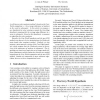Free Online Productivity Tools
i2Speak
i2Symbol
i2OCR
iTex2Img
iWeb2Print
iWeb2Shot
i2Type
iPdf2Split
iPdf2Merge
i2Bopomofo
i2Arabic
i2Style
i2Image
i2PDF
iLatex2Rtf
Sci2ools
75
Voted
ICIP
2005
IEEE
2005
IEEE
Color constancy based on the Grey-edge hypothesis
A well-known color constancy method is based on the GreyWorld assumption i.e. the average reflectance of surfaces in the world is achromatic. In this article we propose a new hypothesis for color constancy, namely the Grey-Edge hypothesis assuming that the average edge difference in a scene is achromatic. Based on this hypothesis, we propose an algorithm for color constancy. Recently, the Grey-World hypothesis and the max-RGB method were shown to be two instantiations of a Minkowski norm based color constancy method. Similarly we also propose a more generale version of the Grey-Edge hypothesis which assumes that the Minkowsky norm of derivatives of the reflectance of surfaces is achromatic. The algorithms are tested on a large data set of images under different illuminants, and the results show that the new method outperforms the Grey-World assumption and the max-RGB method. Results are comparable to more elaborate algorithms, however at lower computational costs.
| Added | 23 Oct 2009 |
| Updated | 14 Nov 2009 |
| Type | Conference |
| Year | 2005 |
| Where | ICIP |
| Authors | Joost van de Weijer, Theo Gevers |
Comments (0)

